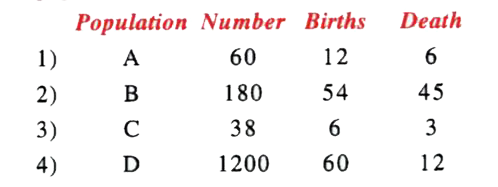The number of death and birth in the last stage of sigmoid growth curve of a population will be
(a) Similar to lag phase
(b) Unequal with more deaths
(c) Unequal with less deaths
(d) Equal
Similar to lag phase
Unequal with more deaths
Unequal with less deaths
Equal
The correct Answer is:D
To solve the question regarding the number of deaths and births in the last stage of the sigmoid growth curve of a population, we can follow these steps:
1. Understand the Sigmoid Growth Curve:
- The sigmoid growth curve consists of four phases: lag phase, exponential (log) phase, transitional phase, and plateau phase. Each phase has distinct characteristics regarding population growth.
2. Identify the Last Stage:
- The last stage of the sigmoid growth curve is the plateau phase. This is where the population growth levels off.
3. Analyze the Plateau Phase:
- In the plateau phase, the birth rate and death rate are nearly equal. This means that the number of individuals being born is approximately the same as the number of individuals dying.
4. Determine the Implication of Equal Birth and Death Rates:
- When the birth rate equals the death rate, the population does not grow, which is referred to as zero population growth.
5. Select the Correct Option:
- Based on the analysis, the correct answer to the question is that the number of deaths and births in the last stage of the sigmoid growth curve is equal.
Thus, the correct answer is (d) Equal.
- The sigmoid growth curve consists of four phases: lag phase, exponential (log) phase, transitional phase, and plateau phase. Each phase has distinct characteristics regarding population growth.
- The last stage of the sigmoid growth curve is the plateau phase. This is where the population growth levels off.
- In the plateau phase, the birth rate and death rate are nearly equal. This means that the number of individuals being born is approximately the same as the number of individuals dying.
- When the birth rate equals the death rate, the population does not grow, which is referred to as zero population growth.
- Based on the analysis, the correct answer to the question is that the number of deaths and births in the last stage of the sigmoid growth curve is equal.
Similar Questions
Knowledge Check
- Question 1 - Select One
Assertion: In sigmoid growth curve, population finally stabilises ilself.
Reason: Finally, the death rate increases than the birlh rale.AIf both Assertion and Reason are true and the Reason is the correct explanation of the Assertion.BIf both Assertion and Reason are true and the Reason is not the correct explanation of the Assertion.CIf Assertion is true but the Reason is falseDIf both Assertion and Reason are false. - Question 2 - Select One
The maximum growth rate is observed during
(a) lag phase
(b) log phase
(c) stationary phase
(d) senescenceAlag phaseBlog phaseCstationary phaseDsemescence - Question 3 - Select One
The growth of a plant or a part when plotted against time shows
(a) linear curve
(b) sigmoid curve
(c) hyperbola
(d) bell-shaped curveAlinear curveBsigmoid curveChyperbolaDbell-shaPed curve
If birth and death rates were equal, a zero population growth rate would result. It is known as
View SolutionIn an area, a population with large size individuals having long life span, more parental care and slow development was present. The type of population growth curve will be
(a) S - shaped
(b) J - shaped
(c) Initially J - shaped then S - shaped
(d) Initially S - shaped then J - shapedView SolutionOsmotic pressure in a vacuolated plant cell is
(a) Equal to W.P.
(b) Equal to T.P.
(c) More than D.P.D.
(d) Less than D.P.D.View SolutionA population that exhibits birth rates that are identical to the death rate implies
(a) Initial growth
(b) Plateau phase
(c) Acceleration phase
(d) Log phaseView SolutionThe births and deaths of four populations A, B, C and D in a year are given below. Which population has the highest growth rate?
 View Solution
View Solution

